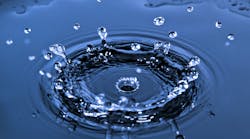A program of the National Research Council of Canada has been investigating water pipe failures. The research suggests that substantial damage occurs before a pipe fails ? damage that current techniques such as leak detection may not discover.
The research is being conducted by the Urban Infrastructure Rehabilitation Program of the Institute for Research (IRC). The IRC?s goal is to learn enough about the way pipes break to develop or improve techniques for detecting the early warning signs of failure.
Most gray cast-iron pipe failures were thought to occur as single events when a pipe snaps across the middle, splits at the bell or along the length. IRC research found this is not always the case. The circumferential breaks and bell splits examined by researchers show evidence that the breaks can occur in several stages.
Each of the failure stages can be identified by differences in the color and chemistry of the rust deposits along the surface of the fracture. Sometimes the shape of the fracture surface also reveals the failure stages, which vary in number.
The research was conducted on piping in Canada. In Toronto, some pipes showed evidence that three different cracking episodes occurred without the pipe breaking across. A blown-out 6-inch pipe from the Regional Municipality of Ottawa-Carleton showed the metal along the edge of the blow out hole was paper-thin at the time of failure. Although the pipe had a protective coating, it appeared to have been scratched during installation, likely by dragging it on the ground. Corrosion pits formed along the scratches.
When an unexpectedly high failure rate occurs in a specific group of pipes, failure analysis can determine whether it is a statistical fluke or due to a cause that will continue producing a large number of pipe failures. In the case of large main breaks, determining the cause is important to ensure that no further failures take place.
Failure analysis examines the ?fracture surface,? the material exposed when the break took place. Water flowing over the fracture surface builds up a coating of corrosion products that hides the causal evidence, but visual examination and chemical analysis of the corrosion products can lead to answers.
Sand blasting removes the corrosion products and exposes the extent of any corrosion pitting. Since sand blasting destroys evidence from the failure, only one of the two fracture surfaces should be cleaned. The other surface remains intact for future examination. Mechanical properties, likely loads and metal quality also need to be considered during a full failure analysis.
Acknowledgement:
Construction Innovation, a quarterly publication of the National Research Council of Canada, Institute for Research in Construction provided this article. The National Research Council of Canada provided the diagram and photographs. For further information contact Dr. Jon Makar at (613) 993-3793; fax (613) 993-5984 or by e-mail: . HYPERLINK mailto:[email protected] [email protected]..
About the Author:
Dr. Jon Makar is a research officer with the National Research Council Canada. He obtained Master?s and Ph.D. degrees from Queen?s University (Kingston, Ontario) and a B.A.Sc. from the University of British Columbia in Vancouver. Currently his research interests include metallurgy and failures of cast iron pipes, non-destructive testing techniques for the water industry and intelligent buildings and infrastructure.


